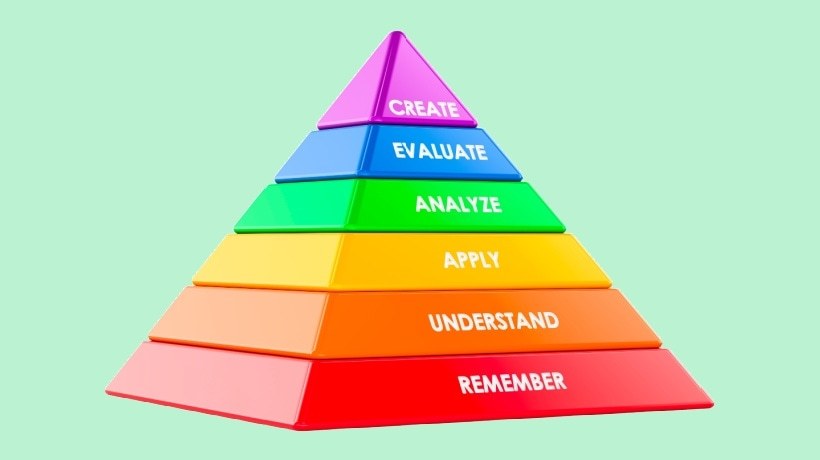Old executive, new relevance
Do your learning goals start by “understanding”, “apply” or “analyze”? If this is the case, you have probably used Bloom taxonomy, whether intentionally or not.
This six -level framework has guided educational designers for decades. But in 2025, with the learning improved by AI, personalized ways and immersive technologies reshaping the way we learn, it's time to ask: should you always use it? Or did he quietly slip into the archives of the history of educational conception?
The answer is not only “yes”. It is “yes, if you know how to make it work for today”.
This article revisits the well -known learning framework of Bloom, assesses its role in digital learning environments and offers suggestions on how modern pedagogical designers can apply it or adapt it to today's Elearning landscape.
What is Bloom's taxonomy?
In 1956, the educational psychologist Benjamin Bloom, as well as a team of researchers, presented a framework called “bloom taxonomy of educational objectives”.
This model aimed to help teachers and educators conceive of better learning experiences by categorizing the levels of thought and learning.
Original taxonomy has focused on the cognitive field, how people acquire and use knowledge, and have been structured as a hierarchy of six categories, the simplest mental skills to the most complex:
- Awareness – Reminder of basic facts, terms and concepts.
- Understanding – Understanding meaning, translation or interpretation.
- Application – Use of equipment learned in new situations.
- Analysis – Decompose the material to understand its structure.
- Synthesis – Assemble parts to form a new everything.
- Assessment – Judge the value of ideas or material.
This version has been widely used for decades to create course plans, assessments and learning results, especially in classrooms and traditional education environments.
Revised bloom taxonomy: Anderson and Krathwohl (2001)
In 2001, a former Bloom student, Lorin Anderson, and the cognitive psychologist David Krathwohl, led a team to revise and modernize the original taxonomy to reflect a more current understanding of learning and teaching:
- Remember
- To understand
- Apply
- Analyze
- Assess
- Create
Here are the key changes in the revised version.
1. Categories based on verbs
Original names (such as “knowledge” or “synthesis”) were changed in verbs to reflect the active nature of learning. For example:
- Awareness became Remember
- Understanding became To understand
- Synthesis became Create
2. Reorganized hierarchy
In the revised version, Create was placed at the highest level, above AssessBecause the creation of something new is considered more complex than assessing existing ideas.
3. Two dimensions
Revised taxonomy has introduced a two -dimensional framework:
- The size of knowledge – Factual, conceptual, procedural and metacognitive knowledge.
- The dimension of the cognitive process – The six levels of reflection: Remember,, To understand,, Apply,, Analyze,, AssessAnd Create.
This allowed educators to classify not only What Students should know, but also how They should think about this knowledge.
Why the revised version is important today
Revised taxonomy is more aligned with modern learning environments, in particular in training in elearning and business. He:
- Use words of action that facilitate and more effective writing objectives of writing.
- Encourages higher order thinking in learning -based, experiential and online learning.
- Supports educational design models like Addie, Sam and backward design.
Using the revised version, educational designers can more precisely align activities, content and assessments on what learners must carry out, in particular in digital and distant learning contexts.
Rethink Bloom's taxonomy for today's learners
Although Bloom's taxonomy remains relevant, today's learners have different expectations. They want learning to be interactive, fast, suitable for mobiles and focused on the real world.
So, how do we adapt Bloom's taxonomy to modern elearning?
1. Pair the bloom taxonomy with real contexts
Instead of abstract tasks, link each level to something that learners could do at work. For example, rather than simply “analyzing data”, encourage learners to “analyze customer comments to improve service”.
2. Use multimedia and simulations
Bloom levels can come to life with interactive videos, connection scenarios, RA / VR and simulations. These tools allow learners to train Apply,, AnalyzeAnd Create In safe and engaging environments.
3. Integrate into agile and fast development models
The traditional educational design was linear. But now agile models like Sam or Design Thinking encourage rapid iteration. Bloom can always adapt by treating it as a flexible guide, not as a book of rigid rules.
Write smart learning objectives using Bloom action verbs
The learning objectives define the basics of your course. They guide the content to include, how learners will interact with him and how success will be measured.
How to do it:
- Use smart criteria (specific, measurable, achievable, relevant, linked to time) when writing objectives.
- Choose precise action verbs in bloom taxonomy depending on the cognitive level you want to target.
- Examples:
- Remember → “List parts of a computer.”
- Analyze → “Differentiating qualitative and quantitative data.”
- Create → “Design a marketing plan for a new product.”
This guarantees clarity for designers and learners, and it helps to follow the learners' progress significantly.
Align content and assessments on the same level of reflection
A current educational design error is disalemination, teaching at one level and evaluation to another.
How to do it:
- If your goal is at Apply Level (for example, “use formulas to calculate the return on investment”), make sure that activities and lesson quizs also ask learners to apply, not only to recall the formulas.
- Avoid testing memory when the objective is analysis or evaluation. Make sure that each quiz, scenario or assignment directly supports the desired flowering level.
This alignment stimulates the efficiency and credibility of learning, in particular in the training of companies or compliance.
Start small, especially for microlearning modules
Microlearning is supposed to be concentrated and easy to consume. Try to teach too much in a short module overwhelms learners and weakens retention.
How to do it:
- Concentrate on a level of Bloom microlearning module, in particular the lower order levels like Remember And To understand.
- Example: Create a short lesson that helps learners to “define phishing attacks” (Remember), and another who shows how “recognize phishing emails” (Apply).
This makes your modules scalable and stackable, so that they can possibly support more complex learning paths.
Use a higher order reflection for Capstone activities or final evaluations
Capstone activities or end -of -less assessments are when learners demonstrate a real mastery.
How to do it:
- Defain learners to analyze, assess or create something using what they have learned.
- Examples:
- Analyze a case study in the real world and provide recommendations.
- Evaluate different software tools and choose the best for a task.
- Create a presentation or a proposal that solves a problem.
These superior tasks help to fill the gap between the theory and the performance of the real world, in particular in vocational training or the development of skills.
Mix the modalities: use text, video, interactive tools and real world tasks
People learn in different ways and digital learning environments provide endless possibilities for multimodal education.
How to do it:
- Use text and infographics to Remember And To understand Levels.
- Include videos or demos for Apply.
- Add connection scenarios, simulations or role -playing games to Analyze And Assess.
- Design projects, narration or real tasks for Create.
The mixture of media not only maintains engagement, but also targets various cognitive levels in Bloom taxonomy, guaranteeing a richer learning experience.
To conclude
Bloom's taxonomy may have been developed in a different time, but its value in the educational design remains timeless. Basically, it is not only a hierarchy of verbs; It is a roadmap for significant learning.
Bloom's taxonomy provides the structure necessary to design the intention, where the content must be engaging, adaptive and focused on results. It helps you balance creativity with clarity, ensuring that each module, quiz or activity advances learners towards an understanding and real performance.
The key is to use it not as a strict formula, but as a flexible thought tool, which evolves with technology, trends and changing needs of your learners.



